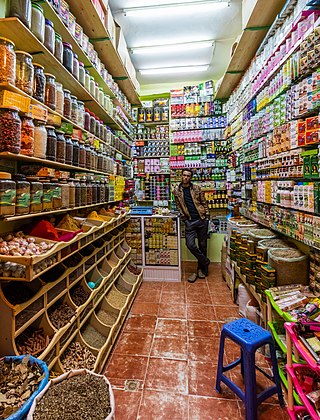Related Research Articles
E-commerce refers to commercial activities including the electronic buying or selling products and services which are conducted on online platforms or over the Internet. E-commerce draws on technologies such as mobile commerce, electronic funds transfer, supply chain management, Internet marketing, online transaction processing, electronic data interchange (EDI), inventory management systems, and automated data collection systems. E-commerce is the largest sector of the electronics industry and is in turn driven by the technological advances of the semiconductor industry.

Shopping is an activity in which a customer browses the available goods or services presented by one or more retailers with the potential intent to purchase a suitable selection of them. A typology of shopper types has been developed by scholars which identifies one group of shoppers as recreational shoppers, that is, those who enjoy shopping and view it as a leisure activity.

Retail is the sale of goods and services to consumers, in contrast to wholesaling, which is the sale to business or institutional customers. A retailer purchases goods in large quantities from manufacturers, directly or through a wholesaler, and then sells in smaller quantities to consumers for a profit. Retailers are the final link in the supply chain from producers to consumers.
Sales promotion is one of the elements of the promotional mix. The primary elements in the promotional mix are advertising, personal selling, direct marketing and publicity/public relations. Sales promotion uses both media and non-media marketing communications for a predetermined, limited time to increase consumer demand, stimulate market demand or improve product availability. Examples include contests, coupons, freebies, loss leaders, point of purchase displays, premiums, prizes, product samples, and rebates.
Multichannel marketing is the blending of different distribution and promotional channels for the purpose of marketing. Distribution channels include a retail storefront, a website, or a mail-order catalogue.

Consumer behaviour is the study of individuals, groups, or organisations and all activities associated with the purchase, use and disposal of goods and services. It encompasses how the consumer's emotions, attitudes, and preferences affect buying behaviour. Consumer behaviour emerged in the 1940–1950s as a distinct sub-discipline of marketing, but has become an interdisciplinary social science that blends elements from psychology, sociology, social anthropology, anthropology, ethnography, ethnology, marketing, and economics.

Online shopping is a form of electronic commerce which allows consumers to directly buy goods or services from a seller over the Internet using a web browser or a mobile app. Consumers find a product of interest by visiting the website of the retailer directly or by searching among alternative vendors using a shopping search engine, which displays the same product's availability and pricing at different e-retailers. As of 2020, customers can shop online using a range of different computers and devices, including desktop computers, laptops, tablet computers and smartphones.
Habitat is a brand of household furnishings in the United Kingdom and the main homewares brand within the Sainsbury's group.

Brick and mortar is an organization or business with a physical presence in a building or other structure. The term brick-and-mortar business is often used to refer to a company that possesses or leases retail shops, factory production facilities, or warehouses for its operations. More specifically, in the jargon of e-commerce businesses in the 2000s, brick-and-mortar businesses are companies that have a physical presence and offer face-to-face customer experiences.
The term mobile commerce was originally coined in 1997 by Kevin Duffey at the launch of the Global Mobile Commerce Forum, to mean "the delivery of electronic commerce capabilities directly into the consumer’s hand, anywhere, via wireless technology." Many choose to think of Mobile Commerce as meaning "a retail outlet in your customer’s pocket."

Visual merchandising is the practice in the retail industry of optimizing the presentation of products and services to better highlight their features and benefits. The purpose of such visual merchandising is to attract, engage, and motivate the customer towards making a purchase.

DirectBuy is an American membership buying service headquartered in Merrillville, Indiana. Members pay a fee, which entitles them to buy products at a discount, directly from the manufacturer and its authorized suppliers. Product categories include home furnishings, home improvement, entertainment, outdoor, flooring, and accessories.
Omnichannel is a neologism describing a business strategy. According to Frost & Sullivan, omnichannel is defined as "seamless and effortless, high-quality customer experiences that occur within and between contact channels".

Showrooming is the practice of examining merchandise in a traditional brick-and-mortar retail store or other offline setting, and then buying it online, sometimes at a lower price. Online stores often offer lower prices than their brick-and-mortar counterparts because they do not have the same overhead cost. Staff writers at the Wharton School have observed that showrooming and buying elsewhere is not new in itself, but its impact has become more significant with the greater availability of online purchasing.

Omnichannel retail strategy, originally also known in the U.K. as bricks and clicks, is a business model by which a company integrates both offline (bricks) and online (clicks) presences, sometimes with the third extra flips.

Kurt Jetta is a consumer researcher who studies data about multinational corporations through his firm, TABS Analytics, which is based in Shelton, Connecticut. The corporations Jetta has analyzed include Amazon, Family Dollar, Dollar Tree, Walmart, Apple. In addition, Jetta has also studied the organic food industry, the vitamin industry, and the online grocery industry. Other investigations led by Jetta include sociological research that pertains to the purchasing habits of various ethnic groups. In the area of trade promotion, Jetta has developed an alternative methodology to current industry baseline models. Jetta also analyzes rewards programs. He was a 2017 Republican candidate in Florida’s 21st Congressional District.
Mobile location analytics (MLA) is a type of customer intelligence and refers to technology for retailers, including developing aggregate reports used to reduce waiting times at checkouts, improving store layouts, and understanding consumer shopping patterns. The reports are generated by recognizing the Wi-Fi or Bluetooth addresses of cell phones as they interact with store networks.
Online to offline, commonly abbreviated to O2O, is a phrase that is used in digital marketing to describe systems enticing consumers within a digital environment to make purchases of goods or services from physical businesses.
The disruptive effect of e-commerce on the global retail industry has been referred to as the Amazon Effect: the term refers to Amazon.com's dominant role in the e-commerce market place and its leading role in driving the disruptive impact on the retail market and its supply chain.
References
- ↑ Research Online Purchase Offline. Die Bedeutung des Internet im Kaufentscheidungsprozess. Archived 2014-04-05 at the Wayback Machine , Google report, 2011. Accessed in February 2014.
- ↑ Entwicklung des Online-Handels in Deutschland. Analyse der Branchensektoren., German retail association/PwC report, 2013. Accessed in February 2013
- 1 2 3 Adler, Emily (July 13, 2014). "'Reverse Showrooming': Bricks-And-Mortar Retailers Fight Back". Business Insider .